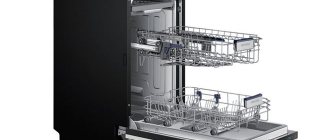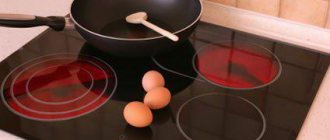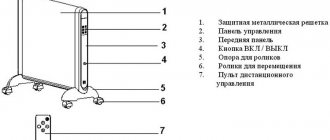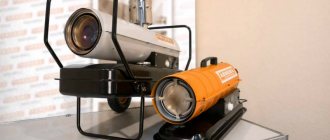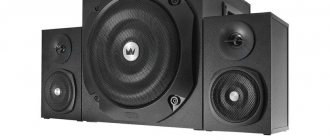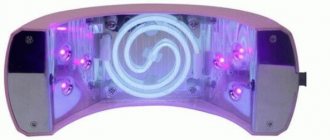TVs with curved screens differ from their analogues in their impressive cost and non-standard appearance. Why do you need such a TV? Are consumers really overpaying solely for original design?
A curved screen also affects the technical characteristics of the device: contrast, viewing angle, image realism, etc. However, how significant is the difference between such TVs and standard models? Let's find out now.
Samsung UE49KU6300
Features of curved screen TVs
Don't forget that curved screens are twice as thick as regular TVs. Such a device will look bad on the wall. To avoid excessive highlighting of the TV along the edges, the equipment must be placed in a pre-created niche.
The comfort zone is another feature that needs a few words about. If the distance from the viewing point to the screen is greater than the diagonal of the TV, then you will not be able to enjoy a high-quality image. The maximum immersion effect will only be if you are in the center and as close to the screen as possible.
Watching TV in a group also becomes noticeably more difficult. Because it is almost impossible to place everyone in the center. Part of the image is lost. The picture becomes too narrow. The distance to the near and far extreme points becomes even more noticeable.
Distortion is another feature common to concave screens. Non-linear distortion occurs when watching a curved TV if you are to the left of your comfort zone. The left side of the picture begins to be in profile.
Xiaomi Mi TV 4S
To objectively evaluate TV equipment, you need to understand the basic technical parameters. Curved and straight screens are significantly different. TVs should be evaluated through the prism of special criteria:
- Brightness. Modern TVs have no problems with this parameter, regardless of the screen type. Users will be able to adjust the brightness of the image;
- Screen resolution. This parameter determines the ratio of the number of pixels per unit area (vertical and horizontal). The higher the resolution, the better the quality of the picture. If the resolution of the video file and the screen match, the image will be perfect;
- Contrast. Indicates the difference in brightness in different areas of the TV screen: from the lightest to the darkest. Contrast can be static or dynamic in different areas of the picture;
- Viewing angle. Defines the maximum permissible angle to the screen plane at which the picture is not distorted. Ideally, this parameter should be 178 degrees;
- Response. Time of change of pixel state. The lower the response, the higher the image clarity. There will be no blur effect;
- Available interfaces. The TV must have everything it needs to sync with other devices;
- Diagonal. Measured in inches. The screen size is determined according to the distance from the viewing point to the screen. The optimal distance is approximately 2-3 diagonals of the TV screen.
Samsung UE40K6500BUX
To determine whether a curved TV is truly superior to a conventional device, compare them using these criteria.
The idea of concave TVs from LG, Samsung, and Sony appeared quite a long time ago. Many companies have used this technology to produce movie screens. A curved screen allows you to solve several important problems:
- Correct transfer of images from the projector to the screen.
- The radius of perception increases for viewers close to the screen.
- Maximum immersion in viewing is ensured, since the person is as if under a dome.
These properties are clearly manifested during viewing in the cinema. However, they are also typical for small curved TVs. Therefore, at home, you can also achieve maximum immersion and optimal radius of perception.
Curved or flat screen TV: which one is better to buy? Advantages and disadvantages
Why do you need a curved screen on TV? What is its advantage over a flat one? Is it true that TVs with concave screens show better? How do TVs with a concave screen work, what is their operating principle, what has changed? In this article we will answer these and many other questions, so sit back and let's go
Well, we’ve all just moved away from the boom of 3D TVs, so here’s a new misfortune for you! Stores are filled with 4K TVs with curved (or concave) screens. Looks good? - yes, it’s beautiful and even a little unusual, although curved screens appeared a long time ago in cinemas. For what? Let's figure it out
- Why bend the screen?
So, well, run your hand over the back of your head, and now look at your navel, have you found an HDMI type connector? No? Then I have to disappoint you: you do not have a digital adapter and, in the old fashioned way, use analog vision, which obeys the usual laws of optics. The entire process, from taking an image (film, photograph) to getting it into our brain, goes through two mandatory stages.
The first stage is the shooting process, in which the image, through the lens of a movie camera, enters the matrix (in the past - film). The quality of the image depends on how well the lens is able to focus the image and how good the matrix is to convey the smallest details.
As you can see, the lens transmits a round image, and the matrix already crops it, making it rectangular. Now let us remember that the TV screen format has become far from the classic rectangle and has become widescreen, with an aspect ratio of 16x9 or even 21x9. How to convey such a wide, in-focus image without loss?
Wide-angle lenses, which are equipped with all modern movie cameras, serve this purpose. Their main task is to shoot objects at close range with a maximum angle of view, without loss of clarity (focus) and with minimal nonlinear distortion.
The second stage is the reception of the image by our eyes, which are an optical device with a curved matrix (retina). The whole trick is that the distance from the lens (lens) to the matrix (retina) is the same everywhere and is equal to the focal length of the lens, which is why we see the picture in focus, clear and without nonlinear distortions
Hence the conclusion : the eye is an ideal optical design with a curved matrix. The radius of curvature of the matrix must be equal to the focal length of the optical device, only in this case we will get a clear picture not only in the center, but also at the edges
- Curved screen in a cinema
Let's move to the cinema hall. A film projector is a point installation, compared to the size of the screen, in other words, it produces an image from one point - its lens, the size of which is only a few centimeters. There are already several meters between the projector and the screen, therefore, the distance that the light ray travels to the center and edge of the screen is different, hence the loss of sharpness
This is the only reason why large-format cinemas have a curved screen; otherwise, there would be no clarity at the edges, and the image itself would become slightly distorted (stretched). And so, thanks to the correct radius of curvature, which is equal to the distance from the screen to the projector, we have the same distance from the lens to any point on the screen.
It should be remembered that the best place in the cinema is in the center, in the green sector, but if you are located outside this sector, the effect of the concave screen will be rather the opposite, because the distance from your eyes to the beginning and end of the screen will differ significantly, eyes They will begin to lose focus and become overly stressed.
The diagram below clearly shows that many VIP seats are located just outside the comfortable viewing zone, so why overpay?
The ideal distance for watching films in cinemas is equal to the diagonal of the screen, so try to take a seat not only in the center, but also at the desired distance from the screen, then the viewing effect will be most beneficial.
- Surround effect in cinema
There are cinemas with a semicircular screen for maximum immersion. These are mainly 4-5D cinemas, in which, to obtain the maximum effect of reality and volume, the image covers the viewing angle of the human eye, and this is from 160 to 180 degrees, if you count peripheral vision.
Such videos are shot with several cameras and then broadcast by projectors positioned in exactly the same way as during filming. In this example, you can see three projectors; one cannot recreate this.
Conclusion : a curved screen in a cinema serves to ensure the same distance from the projector to any point on the screen, thereby achieving maximum clarity and the absence of distortion at the edges of the screen. To enjoy watching, you also need to be inside the comfort sector so that the distance from any point on the screen to your eyes is the same
- Curved TV screen
It’s not in vain that we started the review from cinema screens, now you’ll understand why. A TV, unlike a cinema screen, shines on its own; the image is formed directly in the matrix, the illumination of which is carried out by LEDs (LED display), or the image is formed by the luminous LED pixels themselves (OLED display).
Therefore, such a concept as the focal length from the projector to the screen disappears by itself, as unnecessary, and only the distance from the screen to our eyes remains. We can only sit in our comfort zone, at a distance approximately equal to the diagonal of the screen, and enjoy the picture
If you can afford to buy just such a TV, with a diagonal of 150-200 inches, don’t even think about it, definitely buy it with a curved screen
The rest of the article cannot yet such a home theater and are looking at TVs with curved screens with a diagonal of 22 to 42 inches.
To begin with, you should remember that the thickness of concave TVs is at least twice as thick (about 10-12 cm) and on the wall it will look very clumsy, protruding at the edges, or it needs to be placed in a pre-made wall niche.
Next, have you forgotten about your comfort zone? Are you really going to watch TV from 1 meter away? and alone? If your favorite sofa is further away than the diagonal size of the curved TV, then you will get the opposite effect. Why? I'll tell you now.
If you are at a close distance and in the center, then the immersion effect will be, because the angle of coverage of the field of view by the screen is greater. But as soon as you move away to the usual distance, which is usually 3-4 meters, you are already outside the radius of curvature. Yes, the distance from your eyes to any point on the screen will still be the same, but your eyes will begin to not understand: why is it crooked? It seems like it should be smooth, like a wall
Viewing with family or with friends becomes completely impossible, because you can’t place everyone in the center, and sitting on the side of the screen - so not only is one part of the picture lost (becoming visually narrower), but the distance to the near and far extreme points of the screen begins to vary much more than when watching a regular flat screen TV
This image demonstrates the non-linear distortion that occurs when viewing a curved screen from the left of the comfort zone (center), because the left side of the image begins to look slightly in profile
- Wide viewing angle
A curved screen has the effect of increasing the image size (diagonal) - this is what manufacturers say. Of course, if it is, then it seems to be certain... but in order not to guess, let's study their own advertising picture. Here she is:
The picture shows a TV with a concave, relatively flat, screen and shows that to provide the same viewing angle, a TV with a flat screen of a larger diagonal would be needed, and so the savings are obvious.
OK! Let's use a little Photoshop and move the "reference" flat screen to the correct distance - that is, exactly the distance from which they measured the viewing angle.
Have you noticed this too? That’s right, if you remove the advertising gimmick, then when you install a flat-screen TV in the same place, the viewing angle, on the contrary, will even increase slightly. In other words, no matter how close you sit to the TV, the viewing angle of a flat screen is greater than that of a curved one, but the focal length is yes, on a flat screen it will change from the center to the edge.
- Focal length
We remember that we are not in a cinema and the focal length does not change by tens of meters, there is no projector that needs to be focused on the screen, the screen shines itself, and the distance from our eyes to the center and edge of a 32-42 inch TV when viewed from a normal distance even at 2-3 meters is a difference of about 1-2%. If your eyes begin to lose focus towards the edge of the screen, stop reading the article and urgently run to the ophthalmologist, this is very serious!!!
There are three types of viewing angle or focus of the human eye. Direct vision - 70 degrees, side vision - 120 and peripheral vision - 160. What does this mean? Only that the maximum comfortable focus is 120 degrees, we see everything that goes beyond these limits, but it’s blurry, unclear, this is our “surrounding effect”. In order to see side objects, you need to turn your head, in light of this, these advertising pictures look a little strange:
The edges of the monitor go beyond the boundaries of not only lateral, but even peripheral vision, and there are texts, graphics... how is he going to view them? He needs to constantly move his head, but then he loses the rest of the information on the screen. In any case, it will not be possible to cover the entire screen, and if this is not a computer game with side video effects, then the complete nonsense of such a screen design is clearly visible
- Secrets of curved screens
Have you read this far? Well then, as a bonus, a little secret information. We all remember: the more complex the equipment, the more capricious it is and the lower its reliability, it follows that TVs with curved screens will fail no less often than with a flat screen and it is likely that the help of a specialist You will need. So, the cost of repairing curved TVs will be much higher and this is primarily due to the process of disassembling and subsequent reassembly.
The fact is that the matrix of a curved TV ... as smooth and flat as in conventional LED TVs. She is bent artificially and is constantly in this tense state. In order to bend it like this, the thickness of the protective coating is reduced , so fragility and the likelihood of mechanical defects, such as the occurrence of a crack , increases many times over. Even a slight hit from a ball, toy or other object can be enough to turn a new TV with a concave screen into plastic and scrap metal
A TV with a curved screen should only be viewed directly, that is, it should be located exactly at eye level, and you should be in the center of the screen, at a distance approximately equal to the diagonal of the TV (that is, very close). Any other position of the TV relative to our eyes will cause discomfort and the feeling that the matrix is curved and arched. These arcs are clearly visible even in store advertising pictures, but that’s not all.
Have you noticed that 99% of pictures advertising TVs with a concave screen feature a landscape as an image? Why? Yes, because from the distance at which you need to be from them, only landscapes can be viewed, only they will give the maximum effect of reality and immersion. Need an example? Please imagine that in the picture below there is a large diagonal TV, sit closer and start enjoying the sea, peering into the smallest details that are so clearly visible in the image... You plunge into the beauty of the landscape, but here...
Well, yes, a change in the plot, then there was a general shot, and now there is a close-up, in which we see the face of a seagull, which occupies almost the entire area of the screen and we immediately want to move further away from the screen. So it turns out that most films are not designed to be viewed at close range on a big screen; they are universal, for viewing from different media.
Our eyes only perceive natural scale and volume well; all reductions or increases must be proportional. The heads of people (birds, animals) should be equal to or smaller than their original sizes, but not larger, otherwise, after watching such a movie, the eyes will pop out of their sockets and will hurt a little (just like if we sat in a huge cinema on first row).
- Advantages and disadvantages of concave screens
It's time to take stock and conduct a comparative analysis of flat-screen and curved-screen TVs, identifying the pros and cons of each model.
Pros and benefits of a curved (concave) screen - there is an immersion effect and a small additional volume, with matrix sizes over 60-80 inches - uh... FSE
Disadvantages and disadvantages of a curved (concave) screen - they are more expensive than models with a flat screen - they look clumsy on the wall, protruding at the edges (that is, only installation on a shelf or cabinet) - the cost of repairs is higher than that of flat-screen models - the likelihood of mechanical damage is higher
The following applies to models with a small screen diagonal (less than 50 inches) - limited distance, height and viewing position (the comfort zone can hardly accommodate two people) - even with the correct viewing distance the eyes will be overly strained in close-ups - the curvature of the screen is not 3D mode, you can’t turn it off
Pros and benefits of a flat screen - the cost of purchase, repair and maintenance is lower - the diagonal does not matter - looks great hanging on the wall at any angle - eyes habitually look at the flat screen from any distance - a huge comfort zone for shared viewing (more than 120 degrees) - no nonlinear or pincushion distortion - no eye strain, you can always sit a little further
Pros and cons of a flat screen - there is no slight immersion effect and additional volume
Tell me, how often do you watch 3D films? Especially on 24-36 inch TVs? Almost never anymore? That’s what I mean, I downloaded it, it seems very cool and unusual, but after playing a little, we switch to normal viewing mode, because it is much more comfortable than the seemingly unnatural volume.
- Epilogue
I understand that I’m taking work away from eye doctors, but I’ll say: if you want to watch some beautiful film with effects, go to the cinema (or buy a 100-150 inch TV with a curved screen), but for everyday home viewing you don’t need
TVs and monitors with a curved screen really have a greater immersive effect and can be used perfectly in game pavilions, simulators and in “super-cheap” cinemas, however, it will be uncomfortable to be in front of such a screen for a long time.
It is also worth considering that you need to start with recording equipment, that is, with movie cameras, they should also have a curved matrix, perhaps this will happen in the future, but for now 99% of recording and playback equipment is designed for the flat screens of our TVs.
Advantages and disadvantages of curved TVs
Let's start with aesthetics. Curved models look more modern compared to regular flat TVs. However, there are several pitfalls. Firstly, they are more bulky and voluminous, precisely because of their unusual design. Secondly, they are very difficult to hang on the wall. The process itself is not difficult, but problems will arise with selecting the optimal position.
Samsung UE55NU7500UXUA
By analyzing the pros and cons of a curved screen TV, you can decide whether to purchase such a device. First, let's list the positive qualities:
- glare is reflected well;
- visual perception of the screen increases;
- increased field of view;
- excellent contrast;
- appearance.
The bends of a curved TV also have a negative impact. Main disadvantages:
- When viewing, you need to be in your comfort zone, otherwise the image will be distorted. This is inconvenient for group viewing;
- the overall thickness of the device increases, as a result of which the TV becomes too bulky;
- the effect of curvature appears;
- It is very difficult to fit such a TV into the interior of the room;
- high price.
The cost of maintaining concave TVs is another notable disadvantage. This is explained by the difficulties that arise during the disassembly and subsequent assembly of equipment. Curved TVs are equipped with conventional flat panels. Their deformation is carried out artificially. Therefore, the matrix is constantly in a state of increased tension.
Samsung HU8500
To ensure that the component bends in accordance with the shape of the TV, manufacturers noticeably reduce the thickness of the protective coating. Because of this, the module becomes more fragile. The likelihood of mechanical defects increases.
Avoid marketing gimmicks. Weigh the pros and cons. Having compared the advantages and disadvantages, you will come to the conclusion that, in addition to their beautiful appearance, curved TVs do not have any real technical superiority. For family viewing, this is far from the best solution.
Such models are more suitable for various demonstrations, presentations, and exhibitions. For regular viewing, it is better to buy a flat-screen TV. Direct screens are also not without their drawbacks, but they are intended specifically for home use.
Price/benefit and our final word
As you've probably guessed, we're not fans of curved screens. For the most part, this technology creates more problems than benefits, and several advantages do not cover up the much larger number of objective disadvantages. In addition, such TVs are much more expensive than their flat-panel counterparts. Given the weaknesses of the curvature, we're not sure the price for these TVs is justified.
On the other hand, fans of manufacturers like Samsung, LG and Panasonic have little choice if they want to buy a flagship, since all the best models come with curved screens.
This factor, in part, creates a false impression among potential buyers that the best TVs are those with curved screens. They see that the manufacturer has announced the next flagship, and this flagship has a curved screen, and the consumer begins to think that curvature is cool.
To summarize, I would like to say that the curved screen does not do as much for the TV as we would like, not providing the user with what he expected when buying a curved TV. Yes, it slightly improves the viewing experience, but just a little, and only on large screens. But if you are fascinated by the appearance of such TVs, or just want to be trendy, then go ahead.
17 Sep 2021 S.Denchuk 34078
Share this post
Discussion: there is 1 comment
- Ivan:
10/04/2016 at 10:54Bent TVs certainly look cool, you can’t argue with that!
Answer
Does diagonal size matter?
A very controversial issue. Manufacturers of curved screen TVs claim that size is the determining parameter. It is this characteristic that they justify the high cost of equipment.
QLed Samsung QE 55 Q8C
In theory, a curved screen will provide the maximum level of immersion during the viewing process. The noticeable amount of screen space will be expanded. Add to this the high resolution. Therefore, in theory, a large diagonal curved screen should provide a completely immersive viewing experience and excellent depth.
In practice the situation is different. The newest model with a screen size of 60 inches will not significantly surpass a similar device with a flat display. The actual diagonal of a curved screen is approximately 1 inch larger than a flat screen.
The appearance of additional space helps to increase the field of vision. But this is not a significant difference. Field of view is the degree of viewing while watching TV at a distance of 2.4 meters from the screen. The curved screen will provide an increase in field of view by approximately 1 degree compared to a conventional flat TV.
In fact, immersion and diagonal size do not have a significant impact. You need to calculate the screen size in accordance with the distance from the viewing point to the screen. Therefore, in rooms with a small square footage there is no point in buying devices with a screen diagonal of 60-80 inches. The optimal choice is a distance equal to approximately 2-3 diagonals of the TV screen.
Content:
- 1 A little history
- 2 Technical features
- 3 Additional but important characteristics
- 4 Advantages and disadvantages 4.1 Disadvantages of the concave technique
- 4.2 Less noticeable flaws
- 5.1 Samsung UE48 H8000
With the advent of the new image format - 4K, TV manufacturers are developing new solutions to meet the needs of customers. One of the new products is slightly concave models with an interesting design. Let's figure out whether TVs with curved screens really have increased technical characteristics. Is it worth purchasing them for your home or is it better to choose the classic version with the usual direct monitor?
Reflection and viewing angle
A curved TV will reduce contrast on the sides of the screen. Provided that the viewer is located as close as possible to the source of viewing. Modern video file formats will smooth out the contrast on the sides.
Samsung UE49KS7500U
There are very few comfortable viewing points, so watching TV in a large group will be very uncomfortable. However, this drawback is typical for both straight and concave screens. There are no significant differences between these TVs. The declared advantages of curved TV manufacturers are visible only on paper.
Optical distortion is another important point. The sensor sensors of the matrix, which provide focusing, are located throughout the plane. Therefore, video files are initially designed to be viewed on a flat surface. When a curved surface is involved, the picture may become distorted. This criterion once again confirms that ordinary flat TVs are in no way inferior to curved ones.
During viewing, the sun's rays fall on the screen. The curvature of the plane is a catalyst for changing the angle of refraction of rays, so the amount of glare is reduced. This effect is especially noticeable in rooms with bright lighting. The further the user is from the screen, the more the intensity of the glow of foreign objects on the screen will decrease.
Samsung SUHD UE65JS9000TXRU
Visual increase
A curved TV screen will provide a visual magnification of the image. Even the screen itself will look more voluminous compared to conventional flat displays. However, the effect directly depends on the distance between the screen and the viewing point. The further away the viewer is, the lower the visual perception of screen width. This advantage is also relative.
Visual enlargement is not only an advantage, but at the same time a disadvantage. Due to its design, a curved TV becomes too bulky. Therefore, difficulties arise when placing the device on the wall. It’s easier to put such a TV on a special stand.
Sony KD-50SD8005
The screen seems bigger
The impressions of what is happening on the screen are larger, and in general the panel looks larger than what is recorded in the documentation. To fully enjoy this effect, try sitting at different distances from the device.
If you watch a 55-inch device from 5 meters away, you will notice that the curved TV screen creates the impression of an expanded space. If you sit 3 meters away from such a TV, you will see how the screen visually expands another 3 times.
Immersive viewing
Curved TVs provide the most immersive viewing experience. This advantage is determined by the design of the device. This is why cinemas also install screens of this shape. The image looks as natural and realistic as possible. This effect can be achieved due to the fact that the screen bends. The image “comes out” a little forward, literally flowing around the viewer. Although regular TVs are not much inferior to curved models in this regard.
The first reaction of viewers who watched the film on a curved TV was delight. They think they saw a three-dimensional image without 3D glasses. Although in fact this is an ordinary picture in 2D format. This effect occurs because the curved edges increase the visual perception of depth. Samsung enhances this effect by automatically adjusting the contrast of different parts of the picture.
Samsung QE75Q8С
